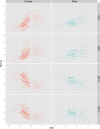Glycans are a novel biomarker of chronological and biological ages
- PMID: 24325898
- PMCID: PMC4049143
- DOI: 10.1093/gerona/glt190
Glycans are a novel biomarker of chronological and biological ages
Abstract
Fine structural details of glycans attached to the conserved N-glycosylation site significantly not only affect function of individual immunoglobulin G (IgG) molecules but also mediate inflammation at the systemic level. By analyzing IgG glycosylation in 5,117 individuals from four European populations, we have revealed very complex patterns of changes in IgG glycosylation with age. Several IgG glycans (including FA2B, FA2G2, and FA2BG2) changed considerably with age and the combination of these three glycans can explain up to 58% of variance in chronological age, significantly more than other markers of biological age like telomere lengths. The remaining variance in these glycans strongly correlated with physiological parameters associated with biological age. Thus, IgG glycosylation appears to be closely linked with both chronological and biological ages. Considering the important role of IgG glycans in inflammation, and because the observed changes with age promote inflammation, changes in IgG glycosylation also seem to represent a factor contributing to aging.
Significance statement: Glycosylation is the key posttranslational mechanism that regulates function of immunoglobulins, with multiple systemic repercussions to the immune system. Our study of IgG glycosylation in 5,117 individuals from four European populations has revealed very extensive and complex changes in IgG glycosylation with age. The combined index composed of only three glycans explained up to 58% of variance in age, considerably more than other biomarkers of age like telomere lengths. The remaining variance in these glycans strongly correlated with physiological parameters associated with biological age; thus, IgG glycosylation appears to be closely linked with both chronological and biological ages. The ability to measure human biological aging using molecular profiling has practical applications for diverse fields such as disease prevention and treatment, or forensics.
Keywords: Aging; Glycome; Glycosylation; Immunoglobulin G; Inflammation..
© The Author 2013. Published by Oxford University Press on behalf of The Gerontological Society of America.
Figures




Comment in
-
Are glycans the Holy Grail for biomarkers of aging?J Gerontol A Biol Sci Med Sci. 2014 Jul;69(7):777-8. doi: 10.1093/gerona/glt202. Epub 2013 Dec 10. J Gerontol A Biol Sci Med Sci. 2014. PMID: 24325897
References
-
- Blair SN, Kohl HW, 3rd, Paffenbarger RS, Jr, Clark DG, Cooper KH, Gibbons LW. Physical fitness and all-cause mortality. A prospective study of healthy men and women. JAMA. 1989;262:2395–2401 - PubMed
-
- Walt D, Aoki-Kinoshita KF, Bendiak B, et al. Transforming Glycoscience: A Roadmap for the Future. Washington, DC: National Academies Press; 2012 - PubMed
-
- Lauc G, Rudan I, Campbell H, Rudd PM. Complex genetic regulation of protein glycosylation. Mol Biosyst. 2010;6:329–335. 10.1039/b910377e - PubMed
-
- Horvat T, Mužinić A, Barišić D, Bosnar MH, Zoldoš V. Epigenetic modulation of the HeLa cell membrane N-glycome. Biochim Biophys Acta. 2012;1820:1412–1419. 10.1016/j.bbagen.2011.12.007 - PubMed
Publication types
MeSH terms
Substances
Grants and funding
LinkOut - more resources
Full Text Sources
Other Literature Sources
Medical

